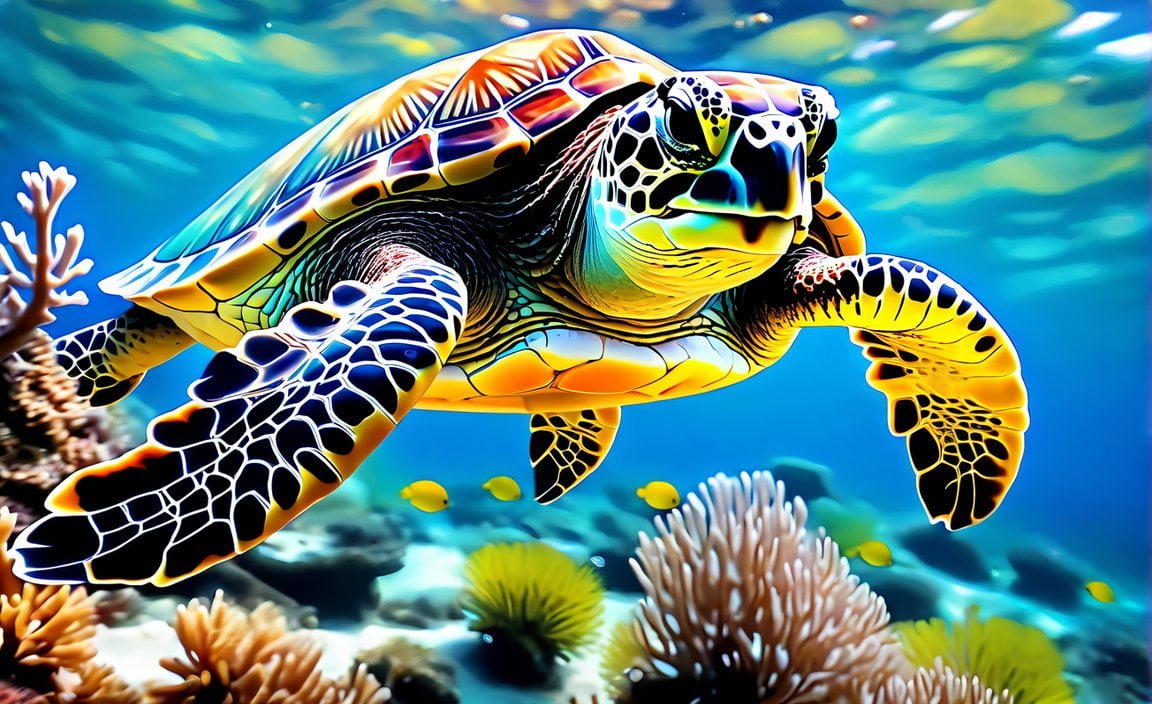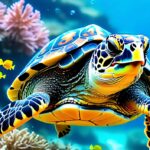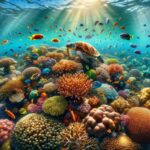Hawksbill Sea Turtles: 10 Fascinating Facts. Delve into the captivating world of hawksbill sea turtles as we uncover ten intriguing facts about these remarkable creatures. From their unique lifecycle to their vital role in coral reef ecosystems, prepare to be amazed by the mesmerizing traits and extraordinary contributions of the hawksbill sea turtle species. Join us on this journey of discovery as we unravel the secrets of these enigmatic creatures and explore the wonders of our ocean’s depths.
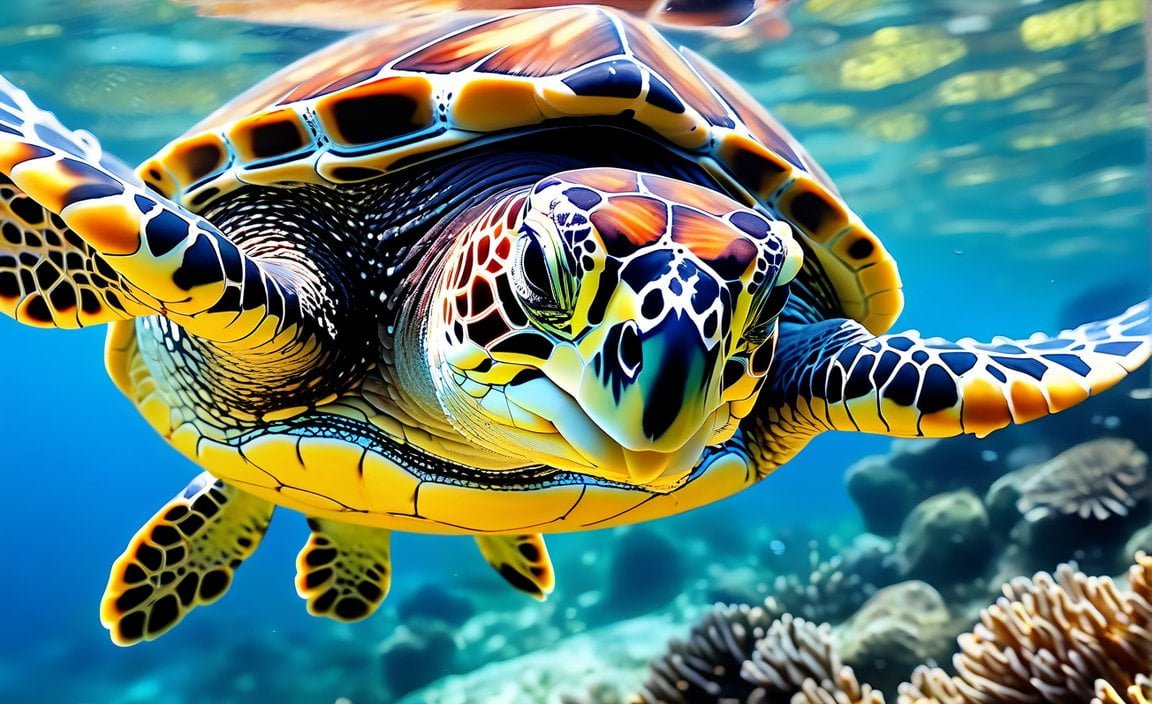
Key Takeaways:
- Hawksbill sea turtles are named for their long, narrow head and hawk-like beak, which they use to reach into crevices and crush and tear their prey.
- Their primary diet consists of sponges, although they also feed on sea grasses, small invertebrates, and algae.
- The largest nesting colony of hawksbill sea turtles is found on Milman Island in Queensland, Australia.
- Hawksbill sea turtles have been swimming in the oceans for much longer than humans have been on Earth.
10 Fun Facts About Hawksbill Sea Turtles
Hawksbill sea turtles are fascinating creatures that play a vital role in the health of our oceans. In this article, we will explore ten intriguing facts about these remarkable turtles.
1. Distinctive Appearance
Hawksbill turtles got their name from their distinctive appearance. With their long, narrow head and hawk-like beak, they stand out among other turtle species. This sharp beak allows them to reach into crevices and skillfully crush and tear their prey.
2. Varied Diet
While hawksbill turtles have a diverse diet, their primary delicacy is sponges. They also feed on sea grasses, small invertebrates, and algae. However, it is the sponges that make up the majority of their diet, providing them with essential nutrients.
3. Milman Island Nesting Colony
The largest nesting colony of hawksbill sea turtles can be found on Milman Island in Queensland, Australia. This beautiful island serves as a haven for these magnificent creatures, providing them with a safe space to lay their eggs and continue their lifecycle.
4. Ancient Mariners
Hawksbill sea turtles have been swimming in the oceans for much longer than humans have been on Earth. They are truly ancient mariners, with a history that predates our existence.
5. Trophic Interactions
These turtles play a crucial role in maintaining the balance of coral reef ecosystems. By feeding on sponges, they control sponge populations, which prevents the sponges from overgrowing and smothering coral reefs. This trophic interaction is essential for the health and diversity of coral reef communities.
6. Long Lifespan
Hawksbill sea turtles have an impressive lifespan. They can live for several decades, with some individuals reaching up to 50 years or more. This longevity allows them to contribute significantly to the marine ecosystem throughout their lifetime.
7. Migration Marvels
Migration is a remarkable behavior observed in hawksbill sea turtles. They undertake long-distance journeys, traveling hundreds or even thousands of miles between nesting and foraging grounds. These migrations contribute to the dispersal of nutrients and the exchange of genetic diversity among populations.
8. Endangered Status
Unfortunately, hawksbill sea turtles are classified as critically endangered by the International Union for Conservation of Nature (IUCN). Threats such as habitat loss, poaching, accidental capture in fishing gear, and climate change pose significant risks to their survival. Conservation efforts are crucial to protect these turtles and their habitats.
9. Unique Shell Patterns
Each hawksbill sea turtle possesses a unique shell pattern, similar to a human fingerprint. These distinct markings allow scientists and researchers to identify individuals and track their movements, providing valuable insights into their behavior and population dynamics.
10. An Ambassador for Marine Conservation
The hawksbill sea turtle serves as a powerful ambassador for marine conservation. Its unique characteristics, important ecological role, and endangered status highlight the need to protect our oceans and preserve the delicate balance of marine ecosystems. By raising awareness and inspiring action, we can contribute to the conservation of these magnificent creatures and their habitats.
Hawksbill sea turtles are truly remarkable creatures. From their distinctive appearance and varied diet to their ancient history and migratory journeys, there is much to learn and appreciate about these magnificent creatures. By understanding and valuing their role in the marine ecosystem, we can work together to ensure their survival for future generations.
Here are 10 fun facts about falcons that will leave you amazed! Prepare to be blown away as you learn about the incredible speed, agility, and hunting skills of these majestic birds. Click here to dive into the fascinating world of falcons!
Discover the mesmerizing world of hawksbill turtles with these jaw-dropping and delightful 10 fun facts. From their uniquely patterned shells to their crucial role in coral reef ecosystems, these endangered creatures have many secrets to unveil. Don’t miss the chance to explore the wonders of hawksbill turtles, click here to start your journey!
They play a crucial role in maintaining healthy coral reef ecosystems
Coral reefs are not only stunning natural wonders, but they also serve as important habitats for countless species, provide protection against wave damage, and play a vital role in the global climate system. The health and sustainability of coral reefs rely on a delicate balance of ecological processes, and one key player in this intricate web of life is the hawksbill sea turtle. These majestic creatures contribute indispensably to the maintenance and flourishing of coral reef ecosystems.
1. They Control Algae Growth on Coral Reefs
Sea turtles, including the hawksbill species, have a unique role in maintaining the health of coral reefs by controlling algae growth. Algae can quickly overtake coral surfaces, hindering the vital process of photosynthesis. Hawksbill sea turtles graze on seagrass beds, preventing overgrowth that can shade coral reefs and hinder their growth. In addition, they consume small pieces of algae that would otherwise settle on the corals, helping to keep them clean and flourishing.
2. They Disperse Coral Larvae
Another fascinating way hawksbill sea turtles contribute to coral reef ecosystems is through their assistance in coral reproduction. As sea turtles graze on seagrass beds and consume various food sources, they inadvertently aid in the dispersal of coral larvae. These microscopic larvae survive the journey through the sea turtle’s digestive system and are eventually released as the turtle defecates. This process contributes to the expansion and genetic diversity of coral reefs, ensuring their continued vitality.
3. They Help Maintain a Balanced Ecosystem
Hawksbill sea turtles’ diets primarily consist of sponges, which are abundant on coral reefs. By controlling sponge populations, these turtles help maintain the balance of the entire ecosystem. If sponge populations were left unchecked, they could overgrow and smother corals, depriving them of essential light for photosynthesis. The presence of hawksbill sea turtles ensures that this delicate balance is upheld, allowing coral reefs to thrive and support a multitude of marine life.
4. They Contribute to Nutrient Cycling
Sea turtles, including hawksbill turtles, play a crucial role in nutrient cycling between coral reefs and seagrass beds. As they graze on seagrass, they consume nutrients that are transported from seagrass meadows to the open ocean. When the turtles return to the coral reefs, they excrete these nutrients, effectively fertilizing the reefs and facilitating the growth of essential organisms. This nutrient exchange is vital for the overall health and productivity of coral reef ecosystems.
5. They Enhance Genetic Diversity
The long-distance migrations undertaken by hawksbill sea turtles, moving between nesting and foraging grounds, contribute to genetic diversity exchange among different coral reef populations. These migrations allow for the mixing of different genetic traits, making the coral reefs more resilient and adaptable to changing environmental conditions. The genetic diversity introduced by hawksbill sea turtles strengthens the overall health of coral reef ecosystems and increases their chances of survival in the face of challenges such as climate change.
Key Takeaways:
- Hawksbill sea turtles play a crucial role in maintaining the health of coral reef ecosystems.
- They control algae growth on coral reefs by grazing on seagrass beds and consuming small pieces of algae that settle on coral surfaces.
- Sea turtles disperse coral larvae through their digestive system, contributing to the expansion and genetic diversity of coral reefs.
- By controlling sponge populations, hawksbill sea turtles help maintain the balance of coral reef ecosystems.
- Hawksbill sea turtles contribute to nutrient cycling between coral reefs and seagrass beds, fertilizing the reefs and promoting growth.
- Their long-distance migrations enhance genetic diversity among coral reef populations and increase their resilience against environmental challenges.
Sources:
– National Oceanic and Atmospheric Administration – Hawksbill Sea Turtles
– World Wildlife Fund – Hawksbill Turtle
Their Diet Consists Mainly of Sponges
Hawksbill sea turtles are fascinating creatures, and one of the most intriguing aspects of their biology is their unique dietary preference. Unlike other species of sea turtles, hawksbill sea turtles are spongivores, meaning their diet consists primarily of sponges. This specialized feeding behavior sets them apart from their marine counterparts.
An Unusual Appetite
Imagine being the only species of sea turtle that can survive on a diet of sponges! It’s truly remarkable. These turtles have developed a specialized feeding adaptation that allows them to feed on sponges with ease. Their narrow, pointed beaks are perfectly suited to picking and tearing apart sponges. This adaptation enables them to access these essential organisms and contribute to the health of coral reef ecosystems.
The Importance of Sponges
Sponges play a vital role in coral reef ecosystems. They compete with corals for space and resources, and their overgrowth can smother and kill corals. This is where hawksbill sea turtles come into play. By feeding on sponges, hawksbills help control their population and maintain a balance in coral reef ecosystems.
Incredible Adaptations
The fact that hawksbill sea turtles are the only sea turtle species that can survive on a sponge diet highlights their incredible adaptability. Sponges can be toxic to other organisms, but hawksbills have evolved mechanisms to handle these toxins. Their digestive system has adapted to process and detoxify the chemicals found in sponges, allowing them to thrive on this unique diet.
Diverse Menu Options
While sponges form the main component of their diet, hawksbill sea turtles are not entirely exclusive in their food choices. They are known to be opportunistic feeders and also consume other items such as mollusks, marine algae, crustaceans, sea urchins, fish, and jellyfish. This diverse menu helps to provide them with a varied nutritional intake and ensures their survival in different ocean environments.
Key Takeaways:
- Hawksbill sea turtles have a specialized diet consisting mainly of sponges.
- Their narrow, pointed beaks allow them to easily feed on sponges.
- By controlling sponge populations, hawksbills contribute to the health and balance of coral reef ecosystems.
- Hawksbills have developed adaptations to handle the toxins found in sponges.
- In addition to sponges, hawksbills also consume various other marine organisms.
Sources:
– NOAA Fisheries
– National Geographic
They Have a Remarkable Ability to Return to Their Birthplace to Lay Eggs
Hawksbill sea turtles, the captivating creatures of the ocean, possess a truly remarkable ability – the power to navigate thousands of miles back to their birthplace to lay their precious eggs. This extraordinary phenomenon, known as natal homing, showcases the innate instincts and navigational prowess of these magnificent creatures.
Throughout their lives, hawksbill sea turtles spend the majority of their time in the vastness of the sea, gracefully exploring the depths of the ocean. However, when the time comes for females to lay their eggs, they embark on an incredible journey back to the very same beach where they first emerged from their eggs. This instinctual pilgrimage allows them to perpetuate their species and ensure the survival of future generations.
Scientists are constantly in awe of this uphill battle against nature’s odds. The oceans are vast and ever-changing, filled with unpredictable currents, shifting landscapes, and a myriad of obstacles. Yet, hawksbill sea turtles possess an uncanny ability to navigate, guided by their internal compass and an intimate knowledge of their birthplace imprinted on their very souls.
These majestic creatures become truly remarkable navigators, enduring hardships and facing numerous challenges to return to their ancestral nesting grounds. As they swim against the currents, they encounter endless perils, ranging from predators lurking beneath the waves to human-induced threats that encroach upon their fragile habitats. Nevertheless, guided by their indomitable spirit, they push forward, fueled by an irresistible force, driven by the promise of new life.
This extraordinary journey is not only a testament to the resilience and determination of hawksbill sea turtles but also highlights the interconnectedness of ecosystems. By returning to their birthplace, they contribute to the vitality and diversity of these precious habitats, enriching the delicate balance of life. As they lay their eggs in the warm sand, they nourish the soil and provide a foundation for the flourishing of other species in the area.
With each hatchling that breaks free from its eggshell and starts its own voyage into the vast ocean, the legacy of the hawksbill sea turtle continues. These remarkable creatures remind us of the marvels of nature and the importance of conservation efforts to protect their nesting sites, safeguard their habitats, and ensure the continuation of their awe-inspiring journey.
Key Takeaways:
– Hawksbill sea turtles possess an innate ability to return to their birthplace to lay eggs, known as natal homing.
– This remarkable journey showcases their navigational prowess and instinctual pilgrimage.
– They endure numerous challenges and overcome unpredictable obstacles during their journey.
– The return of hawksbill sea turtles to their ancestral nesting grounds contributes to the vitality and diversity of ecosystems.
– Conservation efforts are essential to protect their nesting sites and ensure the continuation of this awe-inspiring journey.
Sources:
– The Australian Museum (Australian Museum, n.d.)
– Oceana (Oceana, n.d.)
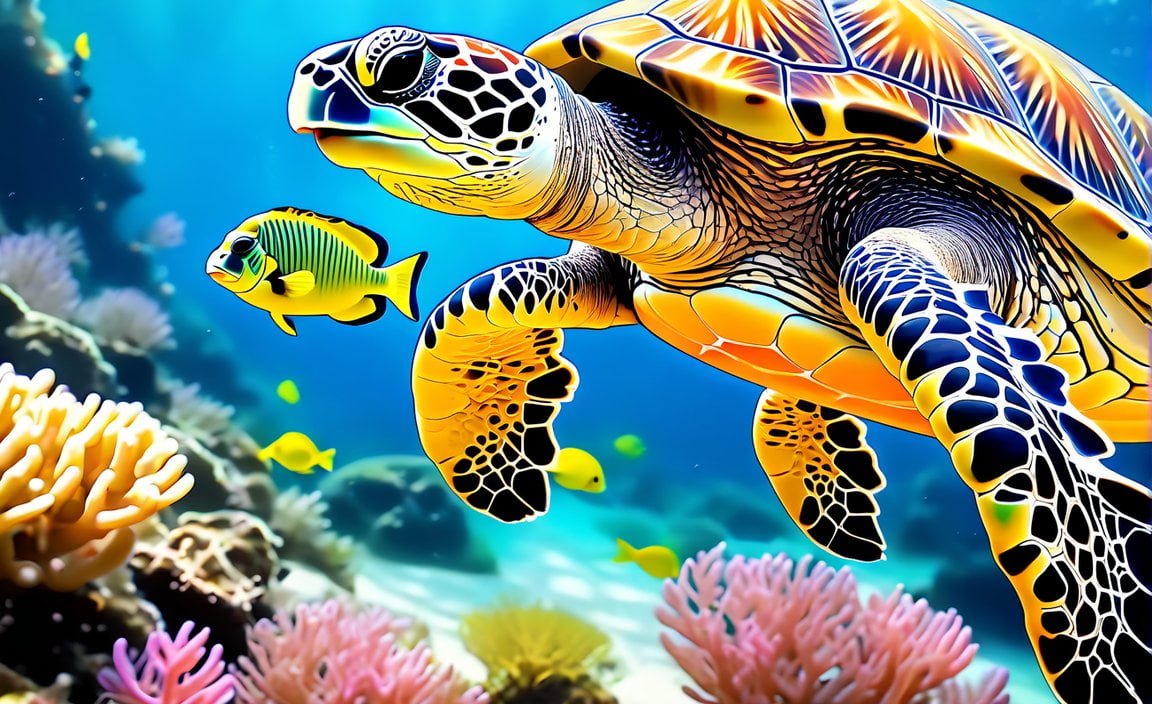
FAQ
Q1: Why are hawksbill turtles called hawksbill turtles?
A1: Hawksbill turtles are called hawksbill turtles because of their long, narrow head and their hawk-like beak.
Q2: What do hawksbill sea turtles eat?
A2: Hawksbill sea turtles primarily feed on sponges, although they also consume sea grasses, small invertebrates, and algae.
Q3: Where is the largest nesting colony of hawksbill sea turtles located?
A3: The largest nesting colony of hawksbill sea turtles can be found on Milman Island in Queensland, Australia.
Q4: How long have hawksbill sea turtles been swimming in the oceans?
A4: Hawksbill sea turtles have been swimming in the oceans for a longer time than humans have been on Earth.
Q5: What is the population size of nesting hawksbill sea turtles?
A5: The population size of nesting hawksbill sea turtles is estimated to be around 20,000-23,000 individuals.
- China II Review: Delicious Food & Speedy Service - April 17, 2025
- Understand Virginia’s Flag: History & Debate - April 17, 2025
- Explore Long Island’s Map: Unique Regions & Insights - April 17, 2025
